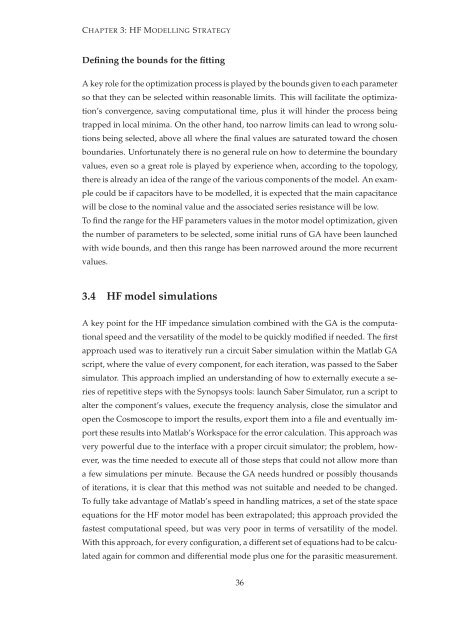PDF (Thesis) - Nottingham eTheses - University of Nottingham
PDF (Thesis) - Nottingham eTheses - University of Nottingham
PDF (Thesis) - Nottingham eTheses - University of Nottingham
You also want an ePaper? Increase the reach of your titles
YUMPU automatically turns print PDFs into web optimized ePapers that Google loves.
CHAPTER 3: HF MODELLING STRATEGY<br />
Defining the bounds for the fitting<br />
A key role for the optimization process is played by the bounds given to each parameter<br />
so that they can be selected within reasonable limits. This will facilitate the optimiza-<br />
tion’s convergence, saving computational time, plus it will hinder the process being<br />
trapped in local minima. On the other hand, too narrow limits can lead to wrong solu-<br />
tions being selected, above all where the final values are saturated toward the chosen<br />
boundaries. Unfortunately there is no general rule on how to determine the boundary<br />
values, even so a great role is played by experience when, according to the topology,<br />
there is already an idea <strong>of</strong> the range <strong>of</strong> the various components <strong>of</strong> the model. An exam-<br />
ple could be if capacitors have to be modelled, it is expected that the main capacitance<br />
will be close to the nominal value and the associated series resistance will be low.<br />
To find the range for the HF parameters values in the motor model optimization, given<br />
the number <strong>of</strong> parameters to be selected, some initial runs <strong>of</strong> GA have been launched<br />
with wide bounds, and then this range has been narrowed around the more recurrent<br />
values.<br />
3.4 HF model simulations<br />
A key point for the HF impedance simulation combined with the GA is the computa-<br />
tional speed and the versatility <strong>of</strong> the model to be quickly modified if needed. The first<br />
approach used was to iteratively run a circuit Saber simulation within the Matlab GA<br />
script, where the value <strong>of</strong> every component, for each iteration, was passed to the Saber<br />
simulator. This approach implied an understanding <strong>of</strong> how to externally execute a se-<br />
ries <strong>of</strong> repetitive steps with the Synopsys tools: launch Saber Simulator, run a script to<br />
alter the component’s values, execute the frequency analysis, close the simulator and<br />
open the Cosmoscope to import the results, export them into a file and eventually im-<br />
port these results into Matlab’s Workspace for the error calculation. This approach was<br />
very powerful due to the interface with a proper circuit simulator; the problem, how-<br />
ever, was the time needed to execute all <strong>of</strong> those steps that could not allow more than<br />
a few simulations per minute. Because the GA needs hundred or possibly thousands<br />
<strong>of</strong> iterations, it is clear that this method was not suitable and needed to be changed.<br />
To fully take advantage <strong>of</strong> Matlab’s speed in handling matrices, a set <strong>of</strong> the state space<br />
equations for the HF motor model has been extrapolated; this approach provided the<br />
fastest computational speed, but was very poor in terms <strong>of</strong> versatility <strong>of</strong> the model.<br />
With this approach, for every configuration, a different set <strong>of</strong> equations had to be calcu-<br />
lated again for common and differential mode plus one for the parasitic measurement.<br />
36
















